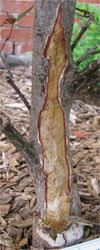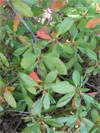Question and Answer – August 2008
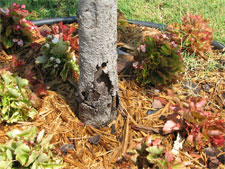
Question: I’ve attached two photos of a Shumard red oak. The tree has been planted for 3 years. It seems to be growing slowly in relation to another red oak I have, but it does produce leaves each year. The base of the tree has somewhat of an opening with the bark peeling back. It has another slit around 42 inches up the trunk. Do you have any ideas as to the cause and what I can do? Should I wrap the trunk? Will the tree survive this problem? J.M., Lewisville.
Answer: This is major trunk damage, and it’s cutting off the supply line of water and nutrients from the roots up to the tree’s canopy. It very likely may be left over from sunscald when the tree was just planted, but it could also have resulted from damage done by tools or rodents. In any event, the tree is trying to heal, but it’s going to be a slow and difficult battle for it. You can see the roll of new bark forming across the wound, but you can also see the cracked and dried internal wood within the exposed tissue. Leave it alone and hope for the best. If the new wood can form over the injury, the tree may gradually regain its strength. Otherwise, you may have to replace it. For the record, every new Shumard red oak (and Chinese pistachio) tree must have its trunk protected with paper tree wrap from the nursery for one to two years to guard against this type of damage.
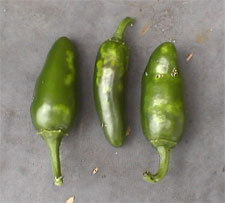
Question: This year the jalapenos in my 7-by-10-foot garden developed yellowish, translucent spots. (See attached photo.) The spots are soft and translucent all the way through the meat. The garden is a newly tilled area, however, it is right next to the old garden area. Could they be unsafe for consumption? O. W., Garland.
Answer: If you’re referring to this summer’s Salmonella outbreak and whether it was due to tomatoes, peppers or whatever, the source was announced this morning (Thursday, July 31) on the news as being Serrano peppers from one Mexican grower and from the irrigation water used on them. The affected fruit apparently never looked unusual, which is one reason it took so long to track the outbreak back to its source. While your jalapenos have suffered some type of mechanical injury due to sunscald, minor insect damage, etc., and while they may not be attractive, they’re not infected with Salmonella. Eat any that measure up to your harvesting standards.

Question: The attached pictures are from a pecan tree that I planted 9 years ago. The bark has always been smooth until this year. My questions are: what makes the bark rough, and why does it peel off, or what could be gnawing the bark as shown in the picture? B.F., Bedford.
Answer: This is really unusual. Pecans traditionally shed big chunks of bark as the trees grow and their trunks expand. That’s normal. However, this seems a little different, almost as if it’s being peeled back by rats or squirrels. That’s especially obvious in the horizontal branch going off to the left. Watch it closely, and hope that it will produce new bark across the exposed areas. Watch for signs of any type of animal activity, then take any necessary steps to stop further damage.
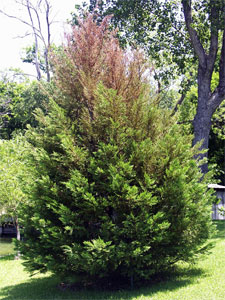
Question: This 15-foot-tall juniper was stricken by a disease that I controlled with Daconil, but not before it killed the top third or so of the shrub. Please let me know if it is worth keeping and will regain a decent shape, or should it be replaced? J.K., Fort Worth.
Answer: Once you’re sure how much of the top is actually completely dead, trim it out and reshape the plant to restore as much symmetry as possible. Fertilize it with an all-nitrogen plant food and keep it well-watered.
I’m torn by the possible cause of your problem, but a disease is not on my radar. This looks exactly like bagworm damage. I zoomed in on your photo to see if I could see any significant number of bags hanging from the twigs and branches. While I saw a few (I think!), it didn’t seem like enough to do serious harm. If you also sprayed the plant with an insecticide before the larvae tied themselves off to the twigs, they may have died and fallen to the ground. The other possibility would be spider mites. They’re nearly microscopic, and they do kill redcedars, but the damage normally develops from the bottom and inside of the plant and then proceeds outward and upward. Thump one of the declining twigs over a sheet of white paper. If the tiny mites are there, you should be able to see them moving around on the paper. A general-purpose insecticide will help reduce their populations.
(For the record, you may very well have a redcedar, but this photo looks a great deal like a Leyland cypress. Their needles and twigs whorl around the branches in flat fans. It doesn’t change my answer, but I just thought I’d comment. Leyland cypresses tend not to be quite as durable to Texas conditions and pests as eastern redcedars.)
Question: Our 2-inch caliper Bloodgood Japanese maple has been very healthy since it was planted about 9 months ago. However, on July 5, I noticed this trunk damage, measuring about 1.5 inches by 9 inches. From the scratch marks, it appears that our neighborhood rats or squirrels enjoyed a bark buffet. The damage to the wood seems limited to the scratches, of which the worst are about 1/16-inch deep. What do you suggest I do to treat this wound, and do you have suggestions for protecting the trunk from future damage? P.M., Plano.
Answer: This seems to be the official "Trunk Damage Issue" of e-gardens! Although it could have been caused by sunscald, we usually plant Japanese maples in heavy shade. Therefore, I’m going to agree on the possibility of rodent damage. As with the reader with the pecan question, you probably should just leave this alone and let the tree heal on its own. You might take a utility knife and trim away the flap of bark, but be very cautious not to score the healthy wood beneath. Try to determine what animal might have been doing the damage.
Question: My azalea bushes are under a native maple tree facing the east. They are not blooming. What could be the problem? They get some morning sun. L.W., no city given.
Answer: These leaves look like they were collected from plants that are somewhat dry and hungry for nitrogen. Azaleas need full sunlight in the mornings, along with shade during the afternoons. The closer you get to Interstate 45 going west from East Texas, the more critical that afternoon shade is. But, they won’t bloom properly when they’re shaded or stunted.
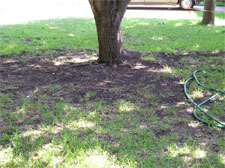
Question: I have always had a nice front yard with thick, green St. Augustine. It may have been neglected somewhat last summer, but it was watered. What seems to be the problem and what can I do to fix it? J., Mesquite.
Answer: While there are many insect and disease problems that attack St. Augustine, this seems to be a clear-cut case of not enough sunlight. St. Augustine needs 4 hours of direct sunlight daily to hold its own and 6 hours to grow vigorously. Look closely at your photo. You’ll see that the problem is worst right around the trunk where the shade is heaviest. You’ll see pockets of thinning grass at the edges of the shadows as the problem enlarges. If you can’t remove lower limbs to allow more sunlight (it appears that that might be a problem), your next step would be to plant a shade-tolerant groundcover such as mondograss, Asian jasmine or purple wintercreeper euonymus.
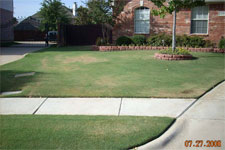
Question: (called in to my radio program on KRLD Sunday morning): Why is my 419 bermuda browning in patches? I use a reel mower, and I try to keep it well watered and fed. What could be causing this problem? L., Metroplex.
Answer: We’re hearing more and more about Take All Root Rot on St. Augustine, almost to epidemic proportions. However, bermuda is also a candidate. When Lance called my radio program this past Sunday asking what might be wrong with his 419 bermuda, it sounded like a buildup of thatch. I asked him to send a photo to e-gardens. Once I saw it, I called in the help of Texas’ finest authority on TARR, Dr. Phil Colbaugh, retired from the Texas Agricultural Experiment Station and now in practice as a turf consultant. Phil is terrific, so I asked my friend to give me his read on the photo. Here, in some technicality, is his reply to me:
"These are typical of the ETRIF causing Bermudagrass Decline on this hybrid bermudagrass lawn. There is another variant symptom from another ETRIF strain causing the miniring disease and this has circular patterns about the size of a dinner plate. I think the key symptom is to look for yellowing (this can be distinguished from drought stress). These yellow patch areas (just like St. Augustinegrass) are active zones where the fungus is producing toxins that migrate upward to the flag leaf of the whorl because the oldest leaf transpires the most water. This lawn should respond well to the peat moss treatment, but you have to do something special with these very dense-textured canopies on the hybrid bermudas. To get the peat to settle in you have to use the fine-cut peat. For this you need to use the select bales of peat. Neil, this is the peat the greenhouse growers use for filling tiny depressions in miniflats to grow seedling crops. The peat is fine enough that you can apply a light topdressing and either brush it in or water it in with a strong water stream or fan nozzle set at high pressure. With the common bermudas the program can be exactly the same as with St. Augustinegrass."


